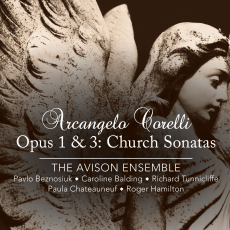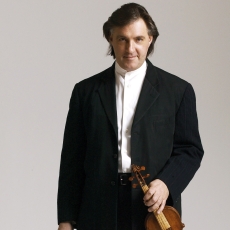The Avison Ensemble - Corelli: Opus 1 & 3 - International Record Review
Previous Linn issues from the Avison Ensemble and Pavlo Beznosiuk have enhanced our expectations and enriched our appreciation of Corelli's groundbreaking instrumental music. Now bringing their former winning ways to the Church Sonatas, Opp. 1 and 3, their two-year long Corellian pilgrimage reaches its conclusion, in performances of captivating freshness, vitality and impressive depth of understanding (the earlier discs were reviewed in February, March and November 2013). As Charles Avison (after whom this group is named) wrote in 1752, ‘the immortal works of Corelli are in the hands of everyone; and accordingly we find that from him many of our best modern composers have generally deduced their elements of harmony'. It was a discerning, if not entirely accurate remark, since at the time, copies of Corelli's works, far from being ‘in the hands of everyone', were coveted, bartered for and sometimes even fought over as musicians everywhere pursued his latest compositions.
Corelli published his Op. 1 set of 12 Sonate di Chiesa in Rome in 1681. Soon afterwards, they were being simultaneously issued by publishing houses throughout Europe, and as Simon D. I. Fielding's instructive booklet notes relate, they ‘remained in print throughout the eighteenth century, a feat unrivalled by any earlier collection'. Corelli himself did not categorize these pieces as ‘Church' Sonatas, though shortly after their publication, an entry in Sébastien de Brossard's Dictionnaire described the genre as ‘proper for the Church - beginning usually with a grave and majestic movement, suited to the sanctity and dignity of such a place, after which comes a gay and animated fugue ...'. Scored for two violins, played here by Beznosiuk and Caroline Balding, with basso continuo provided by Richard Tunnicliffe and Paula Chateauneuf, precisely what Corelli expected as far as the bass instrument was concerned still remains unclear. It was usual at the time to employ either archlute or, more commonly, violone, though a cello has been used throughout this series. The important keyboard continuo is once again thoughtfully realized on harpsichord and organ by Roger Hamilton. However, it is Beznosiuk's daring leadership and audacious virtuosity that constantly brings these superlative accounts to life with palpable urgency and realism. It would be misleading to single out any individual sonata for special comment, but amongst the best known, and typical of the series, is Sonata No. 9, in the notoriously affecting key of F minor, its opening Grave section made even more piquant by the liberal use of diminished seventh chords in the bass line, over which the two violins weave an inexpressibly beautiful dialogue. Small wonder, then, that the historian Sir John Hawkins wrote in 1776 that it ‘had drawn a tear from many an eye', yet the succeeding Vivace, in barbed fugal style, and the final Allegro reveal the fiery brilliance of Corelli's creativity, and there's no one better equipped to convey its sense of frisson and passion than Beznosiuk. It was normal for Corelli to leave the penultimate movements of the Church Sonatas unembellished and one of the most engaging features of the Avison Ensemble's performances is that while there's nothing showy or ostentatious about its use of ornamentation, it always seems genuinely spontaneous. That registers in virtually every slow movement, but these performances are also firmly rooted in period scholarship, too. Beznosiuk must have read Georg Muffat's instructional guide on how to play these pieces. The opening movements are nearly always interspersed with sudden slower interjections and these were, says Muffat David Ponsford Nimbus (a student of Corelli's, incidentally), to be played fulsomely and dramatically: ‘In the opening Sonatas and Fugues and in the affecting Graves that are interpolated, the Italian manner is to be chiefly observed ... those experienced in this art will readily understand this.' As for rival performances, the only serious competition here is the excellent Chandos Chaconne survey by the Purcell Quartet, which brings much fine playing, though tempos are less extreme in fast sections, while recorded sound is brightly focused and clear but lacks the spatial realism of Linn's production. Jakob Lindberg's authoritative playing on both theorbo and archlute adds an extra dimension to the continuo's tonal palette and this set has long been a strong contender here. On balance, though, I prefer the Avison's more spontaneous and vital approach, which never lets historical or stylistic correctness obstruct enjoyment of the music. There remains Enrico Gatti's patchy and uneven recording on Tactus with the Ensemble Aurora. Though decently recorded, these accounts seem four-square and uninspired beside the Avison performances, which must now be the natural first choice here. The last word, however, belongs to Roger North, who memorably described these works as ‘a true pantomime or resemblance of humanity in all its states, actions, passions, and affections'. He could just as easily have been describing these mesmerizing performances themselves - there is none better!


